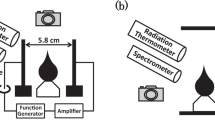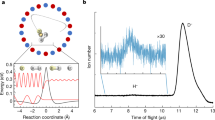Abstract
SOME experiments have recently been made with a flow calorimeter consisting, essentially, of a vertical water-jacketed tube fitted with a burner the height of which could be varied at will. Two similar resistance thermometers, one consisting of a plain platinumrhodium wire and the other a quartz-coated wire, each being of the same overall diameter of 0·0005 in., were placed side by side in the gas stream. The products from the flame could be cooled to any required extent before passing the wires by raising or lowering the burner.
This is a preview of subscription content, access via your institution
Access options
Subscribe to this journal
Receive 51 print issues and online access
$199.00 per year
only $3.90 per issue
Buy this article
- Purchase on Springer Link
- Instant access to full article PDF
Prices may be subject to local taxes which are calculated during checkout
Similar content being viewed by others
References
David and Pugh, NATURE, 145, 896 (1940); also David, Leah and Pugh, Phil. Mag., vii, 31, 156 (1941).
Author information
Authors and Affiliations
Rights and permissions
About this article
Cite this article
LEAH, A. Abnormal Dissociation in Flame Gases. Nature 153, 23–24 (1944). https://doi.org/10.1038/153023b0
Issue Date:
DOI: https://doi.org/10.1038/153023b0
Comments
By submitting a comment you agree to abide by our Terms and Community Guidelines. If you find something abusive or that does not comply with our terms or guidelines please flag it as inappropriate.



